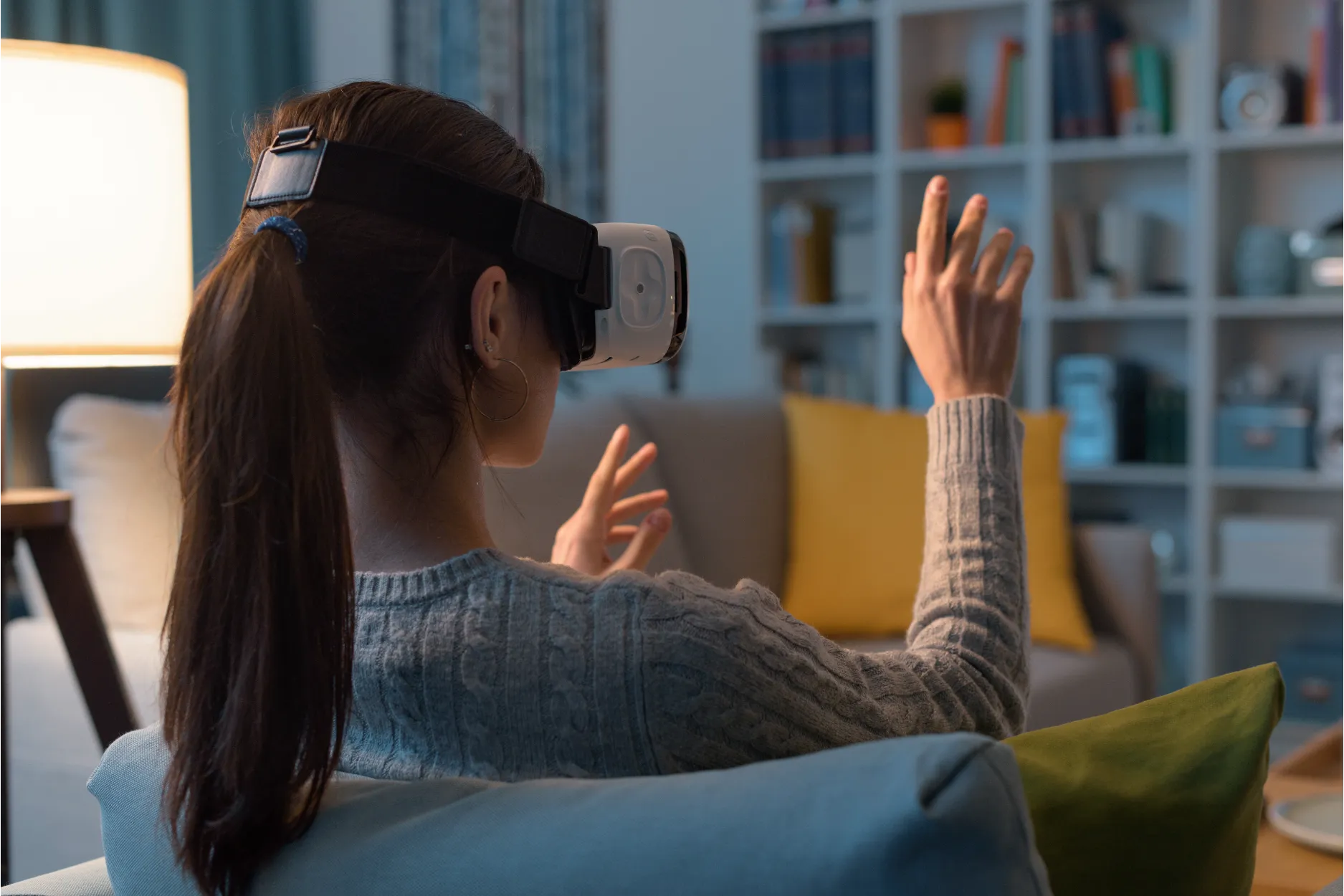
In the captivating world of interior design, where creativity meets functionality, a quiet revolution is underway. Imagine a space where your wildest design visions can take shape, where the boundary between imagination and reality blurs, and where every brushstroke of creativity is brought to life in stunning detail. Welcome to the future of interior design, where the tools we use are as visionary as the spaces we design.
Gone are the days of relying solely on swatches and blueprints to convey design concepts. In this digital age, technology has emerged as the muse of interior designers, offering a palette of groundbreaking possibilities. This blog sets out on a journey to explore the fusion of technology and design, focusing our lens on the thrilling realm of product visualization. We'll dive into a realm where reality is elevated, and dreams find form like never before.
As we embark on this adventure, we'll traverse the evolution of interior design tools, from their humble beginnings to the awe-inspiring present. We'll peek into the treasure trove of virtual reality and augmented reality, witnessing how they've not only disrupted but also enhanced the way we craft interior spaces. We'll unveil the techniques that transform ordinary sketches into hyper-realistic renderings, allowing us to see textures, colors, and lighting with unparalleled clarity.
But this blog is more than just a journey through words; it's an invitation to embrace the future today. From interactive showrooms that teleport you to design wonderlands to AI-powered assistants that turn your musings into masterpieces, we'll unravel the practicality behind these innovations. It's time to bridge the gap between what we envision and what we create, with technology as our trusty guide.
So, fasten your seatbelts, fellow design enthusiasts, as we delve into a new era of design—one where imagination has no limits, where walls can speak volumes, and where innovation reshapes the very essence of creativity. The future of interior design tools is here, and it's waiting for you to take the first step.
In a world where artistic expression meets functionality, interior design has long been a testament to human creativity. Yet, the tools at designers' disposal have often struggled to bridge the gap between imagination and reality. Traditional methods, while charming, could only take us so far in visualizing the potential of a space. Imagine describing the vibrant hues, the interplay of light and shadow, or the texture of fabrics to a client with just words or simple sketches. It was a challenge that left much to interpretation.
Enter the present, where technology has unfurled its wings and embraced the world of interior design. The current state of internal design tools is a dynamic fusion of innovation and aesthetics. No longer bound by the constraints of two-dimensional representations, designers now wield the power of three-dimensional rendering, virtual reality, and augmented reality. These technological leaps allow designers to craft immersive experiences, whisking clients away on a journey through their future spaces before a single piece of furniture is moved.
However, the transition isn't just about pixels and polygons; it's about empowering designers and clients alike to envision the extraordinary. The limitations of yesterday have given way to interactive platforms that bring designs to life. We've moved from static mood boards to interactive virtual spaces where you can almost feel the plushness of a sofa or the coolness of marble underfoot. It's an exciting juncture where imagination and technology dance harmoniously, propelling interior design into uncharted realms.
Join us as we delve deeper into this exciting transformation, exploring how technology is redefining the way we perceive, plan, and execute interior design projects. From traditional tapestries to touchscreens, we're embarking on a journey that's altering the very fabric of design itself.

Step into a world where your wildest design dreams come alive with a simple pair of VR goggles and a touch of augmented reality magic. Can you imagine strolling through the very rooms you've sketched on paper, except now they're right before your eyes in three-dimensional splendor? It's like having a backstage pass to your own imagination!
Say goodbye to flat mood boards and static blueprints. With virtual reality (VR), designers are diving headfirst into their creations. You're not just seeing a room – you're in it. You can practically feel the softness of the cushions, catch the play of light on textured walls, and fine-tune every detail on the fly. And let's not forget augmented reality (AR), the ultimate mix of reality and fantasy. Ever tried placing a virtual lamp in your room using your phone's camera? It's like a sneak peek into the future, right there on your screen.
Big-shot design firms are already in on the action, wowing clients by whisking them away on virtual tours of their yet-to-be-realized spaces. Imagine walking around your future living room, opening virtual cabinets, and giving a nod of approval to finishes you've handpicked. It's not just a design pitch anymore; it's a full-on collaboration where ideas and spaces merge.
So, buckle up for a design adventure where the lines between imagination and reality blur. VR and AR are painting a new canvas for designers, turning what once was a blueprint into a vivid, tangible journey. Get ready to immerse yourself in a world where walls aren't barriers, but gateways to creative wonder.
In the rapidly evolving world of interior design, traditional sketches, and 2D renderings are giving way to a new era of hyper-realistic product visualization techniques. Imagine being able to step into a room that exists only in the realm of imagination, to witness the play of light and shadows on every surface, and to feel the textures of fabrics as if they were right before your eyes. This is the power of 3D modeling and rendering, the cornerstone of next-level product visualization.
With 3D technology, designers can breathe life into their ideas, constructing digital replicas of spaces with intricate details that mimic reality. These digital spaces act as canvases for experimentation, where materials, colors, and layouts can be manipulated effortlessly. By simulating real-world lighting conditions, designers can observe how a room transforms throughout the day, helping them select the perfect shades and tones.
Furthermore, interactive design platforms have ushered in a new era of collaboration. Designers and clients can now co-create in real time, exploring different design elements together. Imagine making on-the-fly adjustments during a virtual meeting, tweaking furniture arrangements, or swapping out decor items while receiving instant feedback. This dynamic and engaging process not only fosters better communication but also ensures that the final design aligns seamlessly with the client's vision.
In the world of interior design, the line between imagination and reality is blurring. Cutting-edge product visualization tools are not only reshaping the design process but also enabling designers to push the boundaries of creativity. The result? Spaces that come alive in ways we could only dream of before.

Step into a world where your dream interior is just a virtual room away. The future of product visualization is here, and it's transforming the way we shop for furniture and decor. Say goodbye to the uncertainty of whether that sleek couch will match your living room or if that vibrant rug will complement your bedroom's aesthetic. With virtual showrooms and augmented reality tryouts, you can explore, experiment, and envision like never before.
Imagine strolling through a digital realm filled with stunning furniture pieces, each curated to spark your creativity. Virtual showrooms are your gateway to a curated collection, where you can walk around, examine intricate details, and visualize how each piece fits into your space. Want to see if that vintage coffee table resonates with your rustic theme or if that modern armchair stands out in your contemporary setting? Just a few clicks, and you're there, soaking in the ambiance.
But why stop at virtual windows? Augmented reality brings the showroom to your home. With a simple app, you can superimpose potential purchases into your actual living space. Place that elegant floor lamp beside your reading nook, or see how that statement mirror complements your entryway. It's like having a personal design assistant right at your fingertips.
These tools not only let you curate your space but also empower you to make well-informed decisions—no more buyer's remorse or design hesitations. The next-level interior design tools are about embracing creativity and transforming it into reality. It's your chance to play, experiment, and bring your vision to life, all before you even make a purchase. The future of shopping is immersive, exciting, and tailored to you.
As we stand on the threshold of a new era in interior design, both designers and consumers must embrace the changing landscape of technology-driven creativity. Here are some invaluable tips to guide you through this transformation:
1. Openness to Innovation: Designers, don't be afraid to experiment with new tools and technologies. The design world is evolving, and those who adapt benefit most. Explore VR, AR, and AI-powered design assistants. Allow these innovations to augment your creative process, opening doors to designs you may not have imagined before.
2. Informed Decision-Making: For consumers, these advanced product visualization tools are your allies. Use them to make informed decisions when selecting furniture and decor. Gone are the days of guessing if that couch will fit your living room – now you can virtually try it before you buy it. Embrace these tools to curate your dream interior with confidence.
3. Learning Curve: Understand that adopting these technologies may come with a learning curve. Designers invest time in mastering these tools. They'll become indispensable assets. For consumers, be patient as you navigate the world of virtual showrooms and augmented reality apps. The more you use them, the easier it becomes.
4. Professional Guidance: Don't hesitate to seek the expertise of professionals. Interior designers with a tech-savvy edge can guide you through the process. They'll help you harness the full potential of these tools, ensuring your space is aesthetically pleasing and functional.
In the ever-evolving realm of interior design, change is the only constant. By embracing these technological shifts, designers can expand their creative horizons, while consumers can make more informed design choices. Together, we'll shape spaces seamlessly blending the physical and digital worlds, and creating truly remarkable interiors.
Read Also: Minimalistic Living Room: 10 Ways To Achieve A Modern And Minimalistic Marvel
In the ever-evolving world of interior design, the future has arrived, and it's nothing short of astonishing. We've journeyed through the transformation of design tools, from the limitations of traditional methods to the boundless possibilities offered by technology-driven product visualization. What we've uncovered is a glimpse into a design realm where imagination meets reality with unprecedented clarity and precision.
As we conclude our exploration, it's clear that embracing these next-level interior design tools is not just an option; it's a necessity. Designers are empowered to dream, create, and innovate like never before. Clients can make informed decisions and watch their visions come to life in real time. The divide between concept and execution has narrowed, fostering a more collaborative and satisfying design experience for everyone involved.
Yet, with this exciting future comes responsibility. Embracing change, learning, and adapting to these tools is crucial. Whether you're a seasoned designer or an enthusiastic homeowner, staying open to new technologies and their possibilities is key to unlocking their full potential.
So, as we look ahead, let's embark on this journey together. Let's celebrate the fusion of artistry and technology, and let's redefine the very essence of interior design. With next-level interior design tools at our fingertips, we have the power to shape spaces that not only meet our needs but also reflect our dreams. The future is here, and it's a canvas waiting for your creative touch.
FAQs
AI in interior design offers benefits such as automated design suggestions, enhanced personalization, and the ability to optimize energy-efficient and sustainable design solutions.
3D modeling enables interior designers to create realistic, three-dimensional representations of spaces and objects, helping clients visualize designs more accurately.
Augmented reality in interior design is a technology that overlays virtual objects, like furniture or decor, onto the real-world environment through a device, allowing you to visualize how they would look in your space.